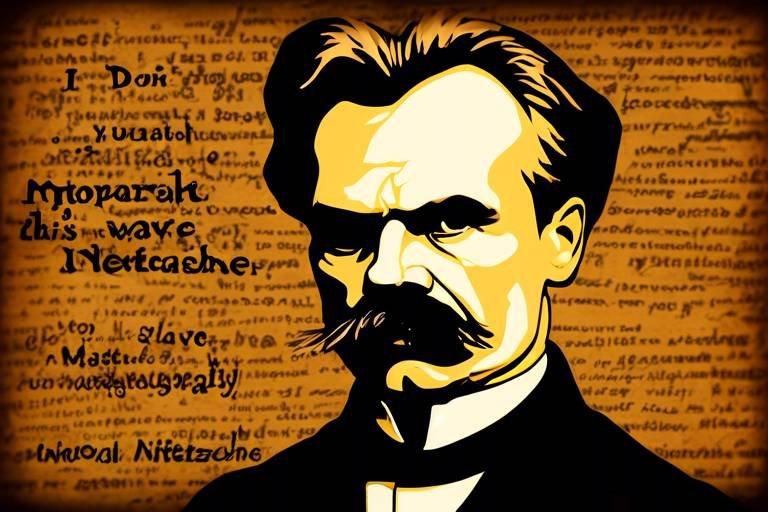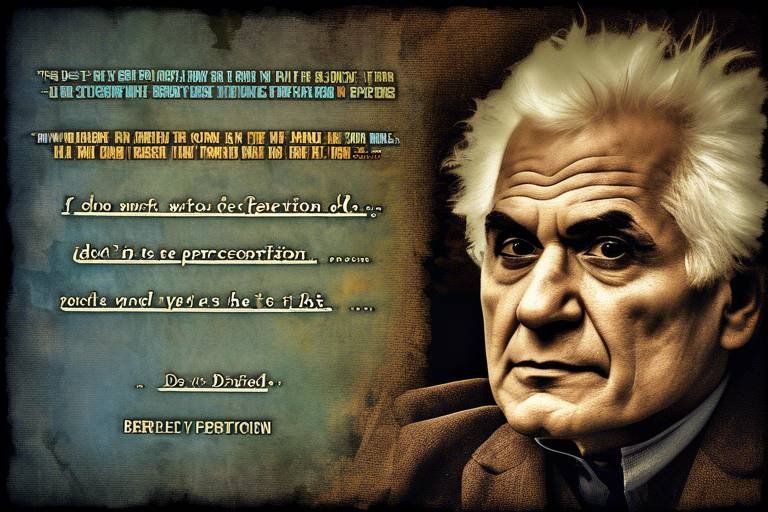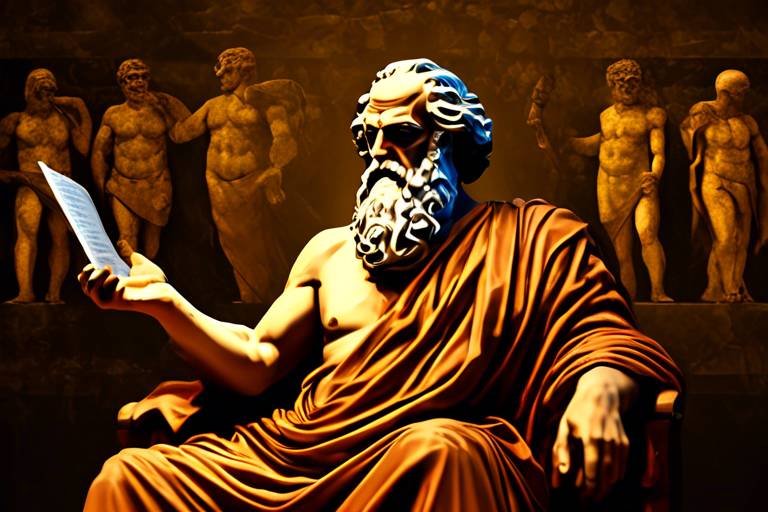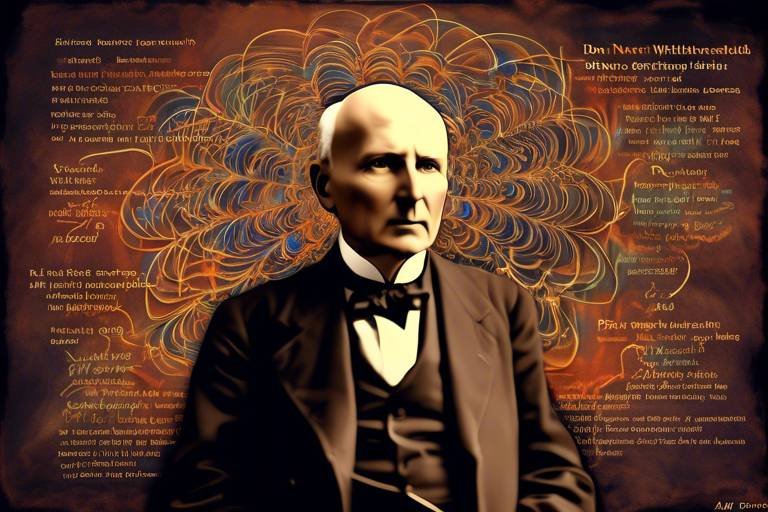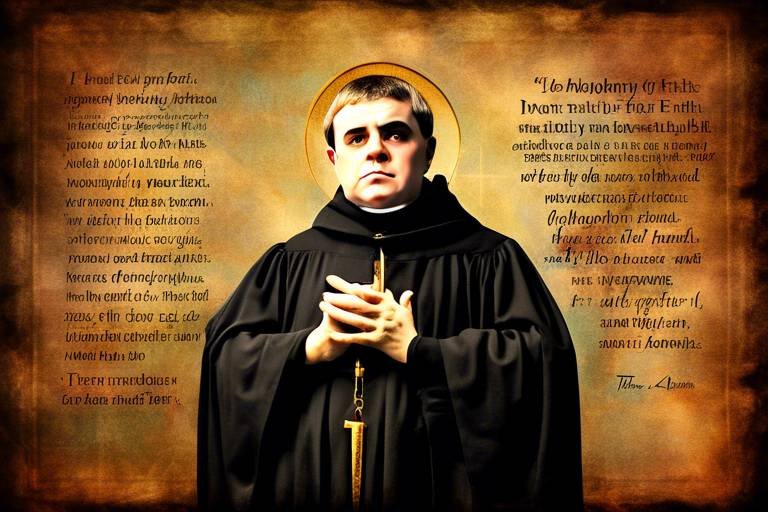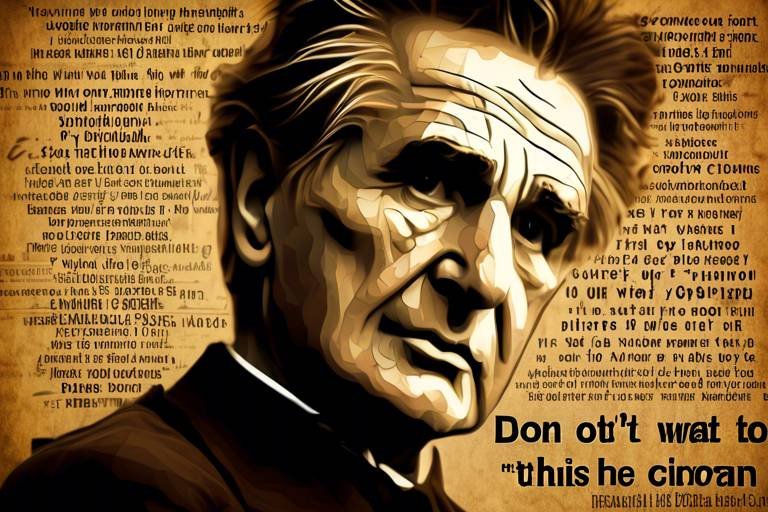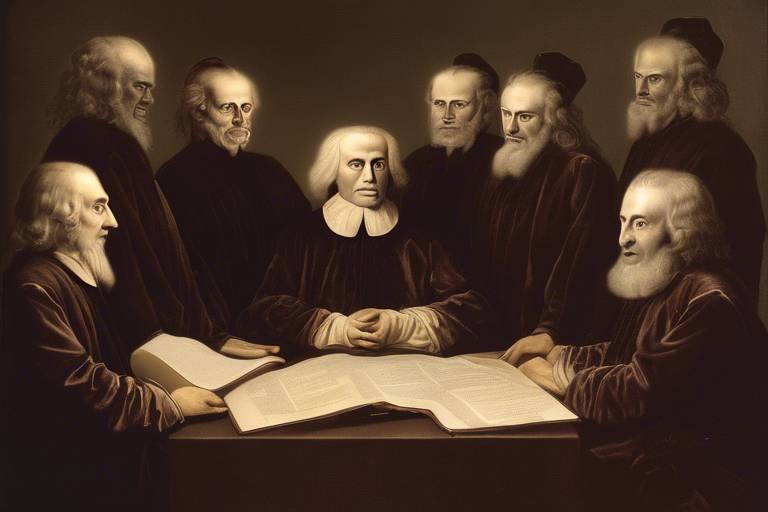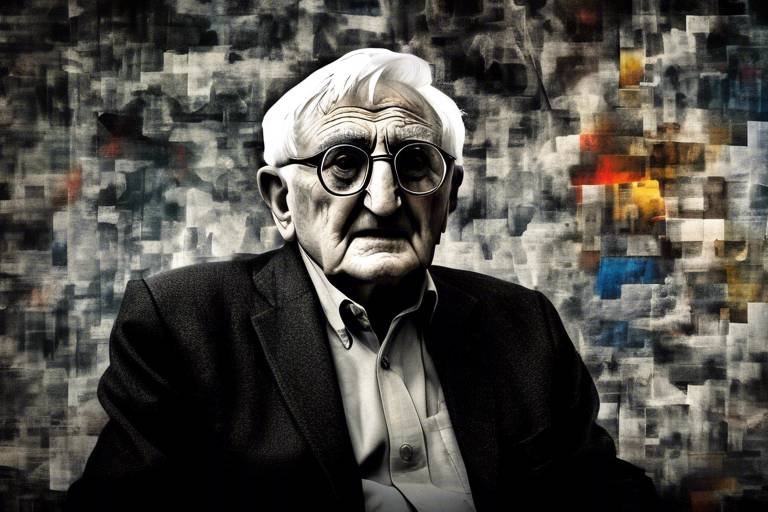Understanding Object-Oriented Ontology - A Philosophical Perspective
Have you ever stopped to think about the objects around you? Not just as mere tools or materials that serve a purpose, but as entities with their own existence and significance? This is the essence of Object-Oriented Ontology (OOO), a philosophical movement that invites us to reconsider our relationship with the world. OOO challenges traditional views that prioritize human experience over the intrinsic value of objects. It opens up a dialogue about how we perceive reality, urging us to acknowledge that objects exist independently of our thoughts and perceptions.
At its core, OOO posits that objects—whether they are a simple rock, a complex machine, or even an idea—have their own essence that is not solely defined by their interactions with humans. This perspective can be quite enlightening, as it encourages us to see the world as a network of relationships between various entities, each with its own agency and significance. Imagine a bustling marketplace: every stall, every product, and every person contributes to the vibrant tapestry of existence, each playing a role that is valuable in its own right.
As we explore OOO, we find ourselves diving into a rich philosophical landscape shaped by influential thinkers such as Graham Harman, Levi Bryant, and Timothy Morton. These philosophers have laid the groundwork for a new way of thinking that transcends the anthropocentric view that has dominated Western philosophy for centuries. By embracing the idea that objects can exist and have value independently, OOO not only reshapes our understanding of reality but also challenges us to rethink our ethical responsibilities towards the non-human world.
In this article, we will delve deeper into the foundations of OOO, exploring its key concepts and implications for various fields, including environmental philosophy and contemporary art. We will examine how OOO redefines the role of objects, blurs the lines between human and non-human relations, and critiques the dominant philosophical stance of correlationism—the idea that human thought is central to understanding reality. Through this exploration, we aim to provide a comprehensive overview of OOO and its significance in modern philosophical discourse.
To fully grasp Object-Oriented Ontology, it's essential to understand its origins. OOO emerged in the early 21st century as a response to the limitations of traditional philosophy, particularly those that prioritize human perception. Philosophers like Graham Harman argue that the focus on human experience has led to a neglect of the objects themselves. In OOO, objects are not merely passive entities waiting to be interacted with; they are active participants in the world.
This shift in perspective invites us to consider objects in a new light. For instance, think about a smartphone. While it serves as a communication tool for humans, it also has its own existence, functionality, and even agency in how it interacts with other devices and systems. This recognition allows us to appreciate the complexity and richness of our environment, encouraging a more holistic understanding of the world.
One of the fundamental principles of Object-Oriented Ontology is the idea that objects exist independently of human perception. This means that an object's value and essence are not contingent upon our awareness or understanding of it. For example, a tree standing tall in a forest has its own significance, whether or not a human is present to admire it. This intrinsic value challenges us to rethink our relationships with the natural world and the objects within it.
In OOO, objects are seen as autonomous beings that interact with one another in a complex web of relationships. This perspective redefines our understanding of reality, emphasizing that objects can influence each other without human involvement. Just as a web of interconnected threads creates a beautiful tapestry, the relationships between objects contribute to the richness of existence.
Object-Oriented Ontology blurs the lines between human and non-human entities, advocating for a more inclusive view of agency. This perspective recognizes that everything from animals to inanimate objects plays a role in shaping our environment. The implications of this are profound: it encourages us to consider the rights and values of non-human entities, fostering a sense of responsibility towards all forms of existence.
Correlationism, the idea that human thought is central to understanding reality, is a significant target for OOO. By critiquing this view, OOO challenges the notion that our perception defines the essence of objects. Instead, it posits that objects have their own reality, independent of human thought. This critique opens up a new realm of philosophical inquiry, inviting us to explore the world beyond our subjective experiences.
Object-Oriented Ontology has far-reaching implications for environmental philosophy. By promoting a deeper appreciation for non-human entities, OOO encourages us to recognize their intrinsic worth in ecological discussions. This perspective can lead to more ethical environmental practices, as we begin to understand that every object, from the smallest insect to the largest tree, plays a vital role in the ecosystem.
In contemporary philosophical discourse, Object-Oriented Ontology has gained considerable traction. Its relevance extends beyond philosophy, influencing fields such as art, science, and technology. Artists, for instance, are increasingly engaging with OOO principles, exploring the relationships between objects and challenging traditional notions of representation.
OOO informs contemporary art practices by encouraging artists to interact with objects in new and meaningful ways. This can manifest in various forms, from installations that highlight the agency of materials to performances that explore the relationships between humans and non-humans. Through these artistic expressions, OOO fosters a deeper understanding of the world around us.
Despite its growing influence, Object-Oriented Ontology faces critiques from various philosophical perspectives. Some argue that it risks overlooking the significance of human experience and the context in which objects exist. Ongoing debates surrounding OOO's validity highlight the dynamic nature of philosophical inquiry, reminding us that no single perspective can encapsulate the complexity of reality.
- What is Object-Oriented Ontology? Object-Oriented Ontology is a philosophical movement that emphasizes the independent existence and intrinsic value of objects, challenging traditional anthropocentric views.
- Who are the key thinkers behind OOO? Influential figures include Graham Harman, Levi Bryant, and Timothy Morton, who have shaped the development of OOO through their writings and theories.
- How does OOO impact environmental philosophy? OOO promotes a deeper appreciation for non-human entities, encouraging ethical considerations and responsibilities towards the environment.
- What are the critiques of OOO? Critics argue that OOO may overlook the importance of human experience and the contextual relationships that objects exist within.

[The Foundations of Object-Oriented Ontology]
Object-Oriented Ontology (OOO) has emerged as a significant philosophical movement that challenges traditional perspectives on objects and their interactions. At its core, OOO posits that objects exist independently of human perception, which is a radical departure from many philosophical doctrines that prioritize human experience as the lens through which reality is understood. The roots of OOO can be traced back to the works of influential thinkers such as Graham Harman, Levi Bryant, and Timothy Morton, each contributing unique insights that have shaped this intriguing field of study.
The inception of OOO can be linked to the broader philosophical discourse surrounding realism and anti-humanism. Philosophers have long grappled with the question of whether objects have value or existence outside of human interpretation. OOO boldly asserts that objects possess their own intrinsic value, independent of human interaction or understanding. This perspective invites us to reconsider our relationship with the world around us, urging us to acknowledge the agency and significance of non-human entities.
In its foundation, OOO draws upon various philosophical traditions, including phenomenology, materialism, and post-structuralism. By synthesizing these ideas, OOO creates a robust framework for examining the myriad relationships between objects. For instance, consider the way we interact with a simple chair. Traditionally, we might think of it solely in terms of its utility for sitting. However, OOO encourages us to see the chair as an independent entity with its own characteristics, history, and significance, regardless of our perception or use of it.
A hallmark of OOO is its critique of correlationism, a term coined by philosopher Quentin Meillassoux to describe the belief that human thought is the central point of reference for understanding reality. OOO challenges this notion by asserting that objects exist and interact in ways that are not contingent upon human thought. This radical shift in perspective opens up new avenues for understanding the interconnectedness of all entities, human and non-human alike.
The implications of OOO extend beyond abstract philosophy; they resonate deeply within contemporary issues such as environmentalism and technological advancement. By recognizing the intrinsic value of non-human entities, we are prompted to engage with our environment in a more respectful and sustainable manner. This shift in perspective not only enriches our philosophical discourse but also encourages a more holistic approach to ecological and technological challenges.
In summary, the foundations of Object-Oriented Ontology challenge us to rethink our place in the world and the nature of our relationships with the objects around us. By asserting the independence and intrinsic value of objects, OOO paves the way for a more inclusive and expansive understanding of reality, one that embraces the agency of all entities, not just those that are human. As we delve deeper into the key concepts of OOO, we will uncover how this philosophy continues to influence various fields and reshape our understanding of existence.

[Key Concepts in OOO]
Object-Oriented Ontology (OOO) introduces a revolutionary framework that shifts our understanding of the world by placing objects at the forefront of philosophical inquiry. One of the most striking concepts within OOO is the notion that objects exist independently of human perception. This idea challenges the traditional belief that objects derive their meaning and existence from human interaction and interpretation. Instead, OOO posits that objects possess their own intrinsic value and agency, irrespective of human acknowledgment. This perspective not only elevates the status of non-human entities but also encourages us to reconsider our relationship with the world around us.
At the heart of OOO lies the assertion that all objects—be they natural, artificial, human, or non-human—are equally significant. This leads to a profound rethinking of how we perceive the relationships between different entities. For instance, consider the relationship between a tree and a smartphone. Traditionally, we might prioritize the smartphone due to its human-centric utility. However, OOO compels us to recognize that the tree, as a living organism, has its own existence and role in the ecosystem that is just as important, if not more so, than the technological marvel in our hands. This radical democratization of objects invites us to appreciate the richness of the world in a more holistic manner.
Another key principle of OOO is the idea of withdrawal. This concept suggests that objects never fully reveal themselves to one another or to human observers. Instead, there is always an element of mystery and obscurity surrounding each object, which means that our understanding of them is inherently limited. This withdrawal can be likened to a magician's trick, where the full extent of the illusion remains hidden from the audience, inviting perpetual curiosity and exploration. Consequently, this concept encourages a more humble approach to knowledge and understanding, as we acknowledge that our grasp of reality is always partial.
Furthermore, OOO emphasizes the interconnectedness of objects, suggesting that they engage in relationships that transcend human experience. For example, consider how a river interacts with the landscape, wildlife, and even human settlements. Each element influences and shapes the others in a complex web of interactions that are not solely dependent on human perception or intervention. This interconnectedness advocates for a more ecological perspective, urging us to recognize the agency of all entities and the importance of their relationships.
In conclusion, the key concepts of Object-Oriented Ontology challenge us to rethink our assumptions about objects and their relationships. By acknowledging the autonomy, intrinsic value, and interconnectedness of all entities, OOO opens up new avenues for understanding the world. It invites us to engage with the myriad of objects that populate our lives, encouraging a deeper appreciation for their roles and significance. As we navigate this philosophical landscape, we are prompted to ask ourselves: How do we relate to the objects around us, and what stories do they tell beyond our human-centric narratives?
- What is Object-Oriented Ontology?
Object-Oriented Ontology is a philosophical perspective that posits that objects exist independently of human perception and emphasizes the intrinsic value and agency of all entities.
- Who are the key thinkers associated with OOO?
Some of the prominent figures in Object-Oriented Ontology include Graham Harman, Levi Bryant, and Timothy Morton, each contributing to the development of its core ideas.
- How does OOO relate to environmental philosophy?
OOO promotes a deeper understanding of non-human entities and their intrinsic worth, encouraging a more inclusive approach to ecological discussions.
- What are the implications of OOO for art and culture?
OOO influences contemporary art practices by encouraging artists to engage with objects in new and meaningful ways, challenging traditional representations and narratives.

[The Role of Objects]
In the realm of Object-Oriented Ontology (OOO), the role of objects takes on a profound significance that challenges our traditional understanding of reality. Rather than viewing objects merely as passive entities that exist to serve human interests, OOO posits that objects possess their own intrinsic value, existing independently of human perception. This shift in perspective invites us to reconsider how we interact with the world around us. Imagine walking through a forest, where every tree, rock, and stream is not just a backdrop to our human experience but a vibrant participant in the ecological narrative. This redefinition of objects compels us to acknowledge their autonomy and the complex relationships they foster with one another.
At the heart of OOO is the idea that objects are not simply defined by their utility or how they are perceived by humans. Instead, they have their own existence and agency. This perspective leads us to ask, "What does it mean for an object to exist?" For instance, consider a chair in your living room. Traditionally, we might see it as a functional piece of furniture, but OOO encourages us to view it as an entity with its own characteristics and interactions, influencing and being influenced by its surroundings. The chair's material, design, and even the history of its creation contribute to its identity as an object.
Furthermore, OOO asserts that the relationships between objects are just as crucial as the objects themselves. These relationships can be intricate and multifaceted, resembling a web of interactions that shape the reality we perceive. For example, a river interacts with the rocks and soil around it, creating a dynamic ecosystem. This interconnectedness suggests that understanding the role of one object necessitates understanding its relationships with others. In this light, we can see that objects are not isolated; they are part of a larger network that contributes to the complexity of existence.
Moreover, the implications of this perspective extend beyond philosophy into practical realms. In environmental discussions, recognizing the role of non-human entities can lead to a more holistic approach to conservation. By acknowledging that every object, whether living or inert, has its own importance, we can foster a deeper appreciation for biodiversity and the intricate balance of ecosystems. This perspective encourages us to advocate for the rights of non-human entities, promoting a more equitable relationship between humans and the natural world.
In summary, the role of objects in OOO is not just about their physical presence but about their **agency**, **relationships**, and **intrinsic value**. This philosophical approach invites us to engage with the world in a more meaningful way, recognizing that every object has a story to tell and a role to play in the grand tapestry of existence. By embracing this mindset, we can cultivate a deeper respect for the myriad entities that share our world, ultimately enriching our understanding of reality itself.
- What is Object-Oriented Ontology? Object-Oriented Ontology is a philosophical framework that emphasizes the independence and intrinsic value of objects, challenging traditional views that prioritize human perception.
- How does OOO change our understanding of objects? OOO redefines objects as autonomous entities that exist beyond human interaction, highlighting their relationships and interactions with one another.
- Why is the role of objects important in environmental philosophy? Recognizing the role of non-human entities promotes a more holistic approach to conservation and encourages respect for biodiversity.

[Human and Non-Human Relations]
In the realm of Object-Oriented Ontology (OOO), the boundaries that traditionally separate human and non-human entities begin to blur, leading to a radical rethinking of how we perceive agency and existence. This philosophical shift invites us to reconsider our place in the world, not as the pinnacle of existence but as one thread in a vast tapestry of relationships. Think about it: just as a spider weaves its web, connecting each strand with purpose and intention, so too do humans and non-humans interact in a complex web of existence.
At the heart of OOO is the idea that all objects—be they living beings, inanimate objects, or even concepts—possess their own intrinsic value. This perspective challenges the anthropocentric view that often prioritizes human experience and understanding over the existence and significance of non-human entities. For instance, consider a tree: traditionally, we might see it as merely a resource for timber or shade. However, OOO encourages us to appreciate the tree as an independent entity with its own life, history, and role within the ecosystem.
Moreover, the relationships between humans and non-humans are not merely transactional. They are dynamic and interdependent. Humans rely on non-human entities for survival—think about the air we breathe, the food we eat, and the materials we use to build our homes. Conversely, non-human entities also influence human behavior and culture. For example, the presence of a river can shape the settlement patterns of communities, while animals can inspire art and folklore, demonstrating that these relationships are far more intricate than mere utility.
OOO advocates for a more inclusive understanding of agency, suggesting that non-human entities also possess a form of agency that impacts their surroundings. This perspective is crucial, especially in discussions surrounding environmental issues. When we begin to recognize the voices of non-human entities—whether it's the cry of a whale or the rustling of leaves in the wind—we open ourselves to a profound dialogue about our responsibilities toward the natural world. In essence, OOO prompts us to ask: What if we listened to the stories told by non-human entities? What insights might we gain?
As we navigate this complex interplay of relationships, it becomes clear that embracing OOO offers a more holistic view of existence. It encourages us to foster respect and empathy for all entities, acknowledging that each plays a vital role in the grand scheme of life. By redefining our relationships with non-human entities, we can cultivate a deeper understanding of our interconnectedness and the responsibilities that come with it.

[The Critique of Correlationism]
At the heart of Object-Oriented Ontology (OOO) lies a powerful critique of correlationism, a philosophical doctrine that posits human thought and perception as the central means through which we understand reality. This perspective, championed by thinkers like Immanuel Kant, suggests that objects only gain meaning through their relationships with human observers. However, OOO boldly steps away from this anthropocentric framework, arguing that objects exist independently of human perception and possess their own intrinsic value.
To grasp the significance of this critique, consider the analogy of a tree in a forest. Traditional correlationism would assert that the tree’s existence and its characteristics are only relevant when a human perceives it. In contrast, OOO insists that the tree has its own life, purpose, and value, regardless of whether a human is present to witness it. This shift in perspective invites us to rethink our relationship with the world around us and recognize the agency of non-human entities.
The challenge posed by OOO to correlationism is profound. It raises several critical questions:
- What happens to our understanding of reality if we detach it from human perception?
- How do we acknowledge the existence and significance of objects that do not require human interaction to validate their being?
- Can we foster a more equitable relationship with non-human entities, recognizing their roles and rights in the ecosystem?
By critiquing correlationism, OOO not only expands the philosophical discourse but also encourages a more inclusive understanding of agency that transcends the human experience. This critique has significant implications for various fields, from environmental philosophy to art, as it challenges us to consider the interconnectedness of all entities—human and non-human alike.
Ultimately, the critique of correlationism serves as a call to action, urging us to reevaluate our assumptions about the world and our place within it. It invites us to embrace a more holistic view of existence, where every object, whether a rock, a tree, or a technological device, holds its own story and significance, regardless of our perception.
In summary, OOO's critique of correlationism not only questions the centrality of human thought but also opens up a rich dialogue about the nature of reality itself. This dialogue is essential for developing a more nuanced understanding of our interactions with the world around us, paving the way for a philosophy that celebrates the autonomy and value of all entities.
- What is correlationism? Correlationism is the philosophical view that knowledge is only meaningful when it is related to human perception or thought.
- How does OOO differ from correlationism? OOO asserts that objects exist independently of human perception, emphasizing their intrinsic value and agency.
- Why is the critique of correlationism important? This critique challenges anthropocentric views, encouraging a broader understanding of reality that includes non-human entities.
- Can OOO influence environmental philosophy? Yes, OOO promotes a deeper appreciation for non-human entities, which can lead to more ethical ecological practices.

[Implications for Environmental Philosophy]
Object-Oriented Ontology (OOO) offers a transformative lens through which we can examine our relationship with the environment. Traditional environmental philosophies often prioritize human interests, viewing the natural world primarily as a resource for human use. However, OOO flips this perspective on its head by proposing that all objects, human or non-human, hold intrinsic value and agency. This shift in viewpoint encourages us to reconsider our role within the ecological web and to recognize the importance of non-human entities.
At its core, OOO challenges the anthropocentric narrative that has dominated environmental thought for centuries. By asserting that objects exist independently of human perception, OOO invites us to appreciate the inherent worth of all entities, from the smallest microorganisms to the largest ecosystems. This perspective fosters a sense of responsibility towards the environment, as it emphasizes that our actions can impact a vast array of beings, each with their own rights to exist and thrive.
Moreover, OOO encourages a more inclusive dialogue about environmental issues. When we acknowledge that non-human entities possess their own forms of agency, we open the door to a richer understanding of ecological relationships. For instance, consider how a river is not just a waterway for human transportation but a complex system that sustains countless life forms. By recognizing the river's agency, we begin to see it as a vital participant in the ecosystem rather than merely a resource to be exploited.
In practical terms, this philosophical shift can lead to more sustainable practices. For example, urban planning that incorporates OOO principles might prioritize green spaces and biodiversity, understanding that these elements contribute to a healthier environment for all. This could manifest in policies that protect habitats, promote rewilding efforts, or encourage the use of materials that minimize harm to non-human entities. The implications are vast and can influence everything from conservation strategies to climate change initiatives.
Furthermore, OOO's emphasis on the interconnectedness of all entities can enhance our understanding of environmental ethics. It prompts us to ask critical questions about our responsibilities towards the environment and how we can advocate for the rights of non-human entities. This is particularly relevant in discussions about climate justice, where marginalized human communities often bear the brunt of environmental degradation, highlighting the need for a holistic approach that considers both human and non-human well-being.
In summary, the implications of Object-Oriented Ontology for environmental philosophy are profound. By challenging traditional anthropocentric views and advocating for the intrinsic value of all objects, OOO encourages a more equitable and sustainable relationship with the environment. This shift not only enriches our understanding of ecological systems but also empowers us to take meaningful action towards preserving the delicate balance of our planet.
- What is Object-Oriented Ontology? OOO is a philosophical framework that posits that objects exist independently of human perception and emphasizes the intrinsic value of all entities.
- How does OOO change our view of the environment? It shifts the focus from human-centered perspectives to recognizing the agency and worth of non-human entities, fostering a more inclusive approach to environmental ethics.
- Can OOO influence environmental policy? Yes, by promoting sustainable practices and policies that respect the rights of all entities, OOO can lead to more holistic environmental solutions.
- What are some practical applications of OOO in environmental philosophy? Applications include conservation strategies, urban planning that prioritizes biodiversity, and climate justice initiatives that consider the rights of non-human entities.

[OOO in Contemporary Philosophy]
Object-Oriented Ontology (OOO) has emerged as a significant player in the landscape of contemporary philosophy, challenging age-old paradigms and inviting fresh perspectives on reality. At its core, OOO posits that objects exist independently of human perception, which fundamentally alters how we engage with the world around us. This paradigm shift has reverberated through various fields, influencing not just philosophical discourse but also art, science, and technology.
One of the most striking aspects of OOO's impact is its ability to encourage a more egalitarian view of existence. By asserting that all objects—whether they are natural, artificial, or even abstract—hold intrinsic value, OOO democratizes the hierarchy of existence. This perspective invites us to reconsider our relationships with non-human entities, urging us to recognize their agency and significance. Imagine a world where a rock or a tree is not merely a backdrop to human activity but a participant in the intricate web of life. This shift in perception can be both exhilarating and daunting, as it challenges us to rethink our role in a universe filled with vibrant, active participants.
In practical terms, OOO encourages interdisciplinary dialogues that transcend traditional boundaries. For example, artists are increasingly inspired by OOO principles, leading to innovative works that explore the relationships between objects and their environments. This has resulted in art that not only represents objects but also engages with them in a dynamic way, prompting viewers to consider their own interactions with the material world. As a result, contemporary art is becoming a medium through which philosophical ideas are not just expressed but actively explored and experienced.
Furthermore, OOO's influence extends into the realms of science and technology. By recognizing the autonomy of objects, scientists are prompted to reassess their methodologies and the assumptions underlying their research. This philosophical lens encourages a more holistic approach to scientific inquiry, where the interconnectedness of all entities is acknowledged. The implications for environmental science, for instance, are profound, as OOO advocates for a deeper appreciation of ecosystems, urging scientists to consider the intrinsic value of all organisms, not just those that serve human interests.
However, the rise of OOO is not without its critiques. Some philosophers argue that its radical departure from human-centered perspectives risks undermining the importance of human experience and agency. This critique often leads to robust debates about the nature of reality and our place within it. Nevertheless, the dialogues sparked by OOO are invaluable, fostering a vibrant philosophical community that is willing to explore the complexities of existence in a nuanced manner.
In conclusion, Object-Oriented Ontology is reshaping contemporary philosophy by challenging traditional notions of existence and agency. Its emphasis on the intrinsic value of all objects opens up new avenues for exploration across various disciplines, encouraging a more inclusive and interconnected understanding of our world. As we navigate this philosophical landscape, it becomes increasingly clear that the questions OOO raises are not just academic; they resonate deeply with our everyday lives and the environment we inhabit.
- What is Object-Oriented Ontology? OOO is a philosophical perspective that posits that objects exist independently of human perception and have intrinsic value.
- How does OOO influence contemporary art? OOO encourages artists to engage with objects in new ways, exploring their relationships and interactions within the material world.
- What are some critiques of OOO? Critics argue that OOO may undermine human agency and experience, leading to debates about its implications for understanding reality.
- In what fields is OOO making an impact? OOO is influencing philosophy, art, science, and environmental studies, promoting interdisciplinary dialogues and new approaches to inquiry.

[OOO and Art]
Object-Oriented Ontology (OOO) has made a significant impact on contemporary art practices, reshaping how artists engage with their materials and the world around them. In a traditional view, art often centers on human experience and perception, but OOO flips this notion on its head, inviting us to consider the intrinsic value of objects themselves. This philosophical shift encourages artists to explore the autonomy of objects, treating them not merely as tools or subjects but as entities with their own presence and significance.
Imagine walking through a gallery where each artwork seems to breathe and exist independently, challenging your perception of what art can be. This is the essence of OOO in art: it pushes boundaries and invites us to see objects as active participants in the creative process. Artists begin to ask questions such as, "What stories do these materials tell?" or "How do these objects interact with one another?" This perspective fosters a deeper connection to the materials, emphasizing that the relationship between artist and object is not one of domination but rather a collaborative dialogue.
Many contemporary artists have adopted OOO principles to create works that reflect this new understanding. For instance, some installations may feature natural elements, like stones or water, presented in a way that highlights their agency and presence. This approach not only engages viewers but also challenges them to reconsider their relationships with the non-human world. The art becomes a medium for exploring the interconnectedness of all entities, human and non-human alike.
Furthermore, OOO encourages artists to experiment with materials that are often overlooked or deemed insignificant. By elevating everyday objects to the status of art, these creators invite us to re-evaluate our assumptions about value and meaning. This can lead to a more inclusive and diverse artistic landscape, where the stories of all objects are told and appreciated. For example, a simple piece of driftwood can become a profound exploration of nature’s resilience and beauty when presented through the lens of OOO.
In the context of exhibitions, the influence of OOO can be seen in the way curators arrange works. Rather than focusing solely on the artist's intent, there is a growing trend to consider how objects interact within the space, creating a dynamic environment that reflects their relationships. This curatorial approach emphasizes the agency of objects and invites viewers to engage with art on a deeper level, fostering a sense of wonder and curiosity.
As we delve deeper into this philosophical framework, it becomes clear that OOO is not just a theoretical concept but a practical tool for artists. It opens up new avenues for creativity, allowing for a more profound exploration of the world around us. By embracing the autonomy of objects, artists can create works that resonate on multiple levels, challenging viewers to rethink their perceptions and relationships with the material world.
- What is Object-Oriented Ontology? OOO is a philosophical movement that posits objects exist independently of human perception, emphasizing their intrinsic value.
- How does OOO influence art? OOO encourages artists to engage with materials as autonomous entities, fostering a deeper connection and exploration of their relationships.
- Can OOO change how we view everyday objects? Yes, by highlighting the significance of all objects, OOO invites us to appreciate their stories and roles in our lives.

[Critiques and Challenges]
Object-Oriented Ontology (OOO) has stirred quite the pot in philosophical circles, and with its rise, a slew of critiques and challenges have emerged. While proponents of OOO argue for a radical rethinking of how we perceive objects, critics often counter with concerns over the implications of such a shift. One significant critique revolves around the idea of absolutism in OOO. Detractors argue that by granting objects an inherent value independent of human perception, OOO risks overlooking the relational dynamics that define our interactions with the world. In other words, can we really separate the essence of an object from the context of human experience?
Furthermore, some philosophers assert that OOO's focus on the autonomy of objects leads to a form of ontological flattening. This perspective suggests that by treating all entities as equally significant, we might dilute the unique qualities that differentiate human experiences from those of non-human entities. Critics warn that this could lead to a dangerous equivalency, where the value of human life and agency is undermined in favor of a more generalized view of existence.
Another challenge OOO faces is its perceived anti-humanism. While the movement seeks to decentralize human experiences in favor of a more inclusive ontology, some argue that this approach can inadvertently alienate the very beings it aims to elevate. The question arises: does OOO truly advocate for a more equitable understanding of agency, or does it simply replace one form of anthropocentrism with another? This debate is crucial as it touches on our ethical responsibilities toward both human and non-human entities.
Moreover, OOO has been critiqued for its sometimes abstract language and complex theoretical frameworks, which can render it inaccessible to broader audiences. Critics argue that if a philosophical framework cannot be easily communicated or understood, it risks becoming irrelevant. This raises an essential question: how can OOO bridge the gap between philosophical discourse and practical application in everyday life?
Despite these critiques, OOO continues to provoke thought and discussion in various fields, from environmental philosophy to contemporary art. It challenges us to reconsider our relationships with the world around us and to recognize the intrinsic value of all entities, human or not. The ongoing debates surrounding OOO serve as a testament to its significance in contemporary philosophical discourse, highlighting the importance of critical engagement with new ideas.
- What is Object-Oriented Ontology?
Object-Oriented Ontology is a philosophical movement that posits that objects exist independently of human perception and have their own intrinsic value. - What are some critiques of OOO?
Critiques of OOO include concerns about absolutism, ontological flattening, anti-humanism, and the accessibility of its language. - How does OOO influence environmental philosophy?
OOO promotes a deeper appreciation for non-human entities and their intrinsic worth, encouraging a more inclusive view of ecological discussions. - Can OOO be applied to art?
Yes, OOO informs contemporary art practices by encouraging artists to engage with objects in new and meaningful ways, exploring their relationships and significance.
Frequently Asked Questions
- What is Object-Oriented Ontology (OOO)?
Object-Oriented Ontology is a philosophical movement that emphasizes the autonomy of objects, suggesting that they exist independently of human perception. This perspective challenges traditional views that prioritize human experience and cognition in understanding reality.
- Who are the key thinkers behind OOO?
Some of the prominent figures in the development of Object-Oriented Ontology include Graham Harman, Levi Bryant, and Timothy Morton. Their works have significantly shaped the discourse around OOO and its implications for philosophy and other fields.
- How does OOO redefine the role of objects?
In OOO, objects are seen as having their own intrinsic value and agency, independent of human interaction. This redefinition encourages us to consider the relationships between objects themselves, rather than solely focusing on how they relate to humans.
- What is the critique of correlationism in OOO?
Correlationism is the philosophical view that human thought and perception are central to understanding reality. OOO critiques this stance by asserting that objects exist beyond human perception, emphasizing a more democratic view of existence where non-human entities also hold significance.
- How does OOO impact environmental philosophy?
OOO encourages a deeper appreciation for non-human entities in ecological discussions, promoting the idea that these entities possess intrinsic worth. This perspective can lead to more inclusive environmental practices that recognize the value of all beings, not just those that are human.
- In what ways does OOO influence contemporary art?
Object-Oriented Ontology inspires artists to engage with objects in innovative ways, encouraging them to explore the relationships and meanings that arise from these interactions. This can lead to new forms of artistic expression that challenge conventional understandings of art and objects.
- What are some criticisms of OOO?
Critics of OOO argue that it may downplay the importance of human experience and the social dimensions of existence. Some also question its practical applications in addressing real-world issues, suggesting that a balance between human and non-human perspectives is necessary.




